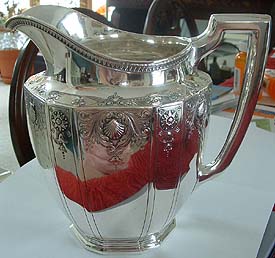
Sterling silver is an alloy of silver containing 92.5% by weight of silver and 7.5% by weight of other metals, usually copper. The sterling silver standard has a minimum millesimal fineness of 925.

A goldsmith is a metalworker who specializes in working with gold and other precious metals. Nowadays they mainly specialize in jewelry-making but historically, goldsmiths have also made silverware, platters, goblets, decorative and serviceable utensils, and ceremonial or religious items.

The Worshipful Company of Goldsmiths, commonly known as the Goldsmiths' Company, formally titled The Wardens and Commonalty of the Mystery of Goldsmiths of the City of London, is one of the Great Twelve Livery Companies of the City of London. The company's headquarters are at Goldsmiths' Hall in the City of London.
The white metals are a series of often decorative bright metal alloys used as a base for plated silverware, ornaments or novelties, as well as any of several lead-based or tin-based alloys used for things like bearings, jewellery, miniature figures, fusible plugs, some medals and metal type. The term is also used in the antiques trade for an item suspected of being silver, but not hallmarked.
A hallmark is an official mark or series of marks struck on items made of metal, mostly to certify the content of noble metals—such as platinum, gold, silver and in some nations, palladium. In a more general sense, the term hallmark can also be used to refer to any distinguishing mark.
Assay offices are institutions set up to assay precious metals. This is often done to protect consumers from buying fake items. Upon successful completion of an assay the assay offices typically stamp a hallmark on the item to certify its metallurgical content. Hallmarking first appeared in France, with the Goldsmiths' Statute of 1260 promulgated under Étienne Boileau, Provost of Paris, for King Louis IX.
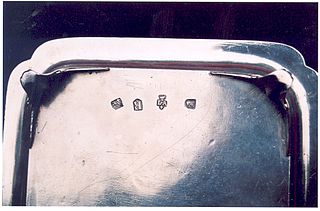
Britannia silver is an alloy of silver containing 11 ozt 10 dwt silver in the pound troy, equivalent to 23⁄24, or 95.833% by weight (mass) silver, the rest usually being copper.
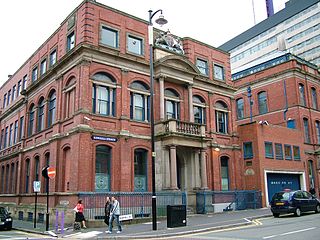
The Birmingham Assay Office, one of the four assay offices in the United Kingdom, is located in the Jewellery Quarter, Birmingham. The development of a silver industry in 18th century Birmingham was hampered by the legal requirement that items of solid silver be assayed, and the nearest Assay Offices were in Chester and London. Matthew Boulton and Birmingham's other great industrialists joined forces with silversmiths of Sheffield to petition Parliament for the establishment of Assay Offices in their respective cities. In spite of determined opposition by London silversmiths, an Act of Parliament was passed in March 1773, just one month after the original petition was presented to Parliament, to allow Birmingham and Sheffield the right to assay silver. The Birmingham Assay Office opened on 31 August 1773 and initially operated from three rooms in the King's Head Inn on New Street employing only four staff and was only operating on a Tuesday. The first customer on that day was Matthew Boulton.
Argentium silver is a brand of modern tarnish-resistant silver alloys, containing either 93.5% or 96% silver. Argentium alloys replace some of the copper in the traditional sterling silver alloy with the metalloid germanium. Argentium's patents refer to percentages of zinc and boron present in Argentium silver. Both Argentium alloys exceed the standard required for hallmarking as sterling silver and Argentium silver 960 meets the standard for hallmarking as Britannia silver.

The Hallmarking Act 1973 makes up the bulk of modern law regarding the assaying and hallmarking of metals in the United Kingdom. Hallmarking is a way to guarantee the purity of precious metals. Metals are tested and, if they meet a certain minimal purity requirement, are marked with a specified seal. In the United Kingdom (UK), this is done by the Assay Offices in London, Birmingham, Sheffield, and Edinburgh. The Act made business transactions involving unmarked metals illegal. Trading Standards departments are responsible for enforcing the Act.
The Dublin Assay Office was established in 1637 to supervise the assaying of all gold and silver throughout the whole Kingdom of Ireland, when the Dublin Company of Goldsmiths was founded by royal charter, re-establishing the medieval Guild of All Saints.

A silver object that is to be sold commercially is, in most countries, stamped with one or more silver hallmarks indicating the purity of the silver, the mark of the manufacturer or silversmith, and other (optional) markings to indicate date of manufacture and additional information about the piece. In some countries, the testing of silver objects and marking of purity is controlled by a national assayer's office.
In medieval and Renaissance Germany, the Münzwardein was the title of an official whose duties included supervising the Münzmeister and the stock of precious metals used in minting. He was responsible for the quality of alloys and the accuracy of weights and measures.
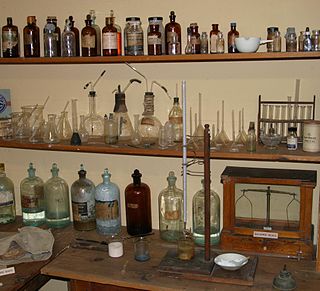
A metallurgical assay is a compositional analysis of an ore, metal, or alloy, usually performed in order to test for purity or quality.
Sara Jocelyn Margarita Elissa Burton was an award-winning British silver and goldsmith. Burton was the first woman to receive the City and Guilds of London Institute top award, the Prince Philip Medal.
‘'’Hersey & Son'’’ is a company founded in Clerkenwell, England. The company is a noted firm of Silversmiths with a history dating back to 1955 when Michael Hersey started his apprenticeship and to 1971 when he and David Mills founded the firm.

The BIS hallmark is a hallmarking system for gold as well as silver jewellery sold in India certifying the purity of the metal. It certifies that the piece of jewellery conforms to a set of standards laid by the Bureau of Indian Standards, the national standards organization of India. India is the second biggest market for gold and its jewellery.
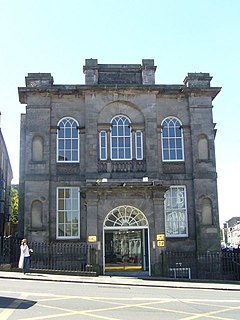
The Edinburgh Assay Office is the last remaining Assay Office in Scotland and one of four which remain in the United Kingdom.
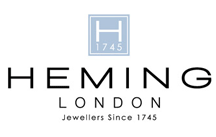
Heming is a British jewellery company, founded in London in 1745. The company has a showroom in the Piccadilly Arcade near to the original store on Piccadilly.
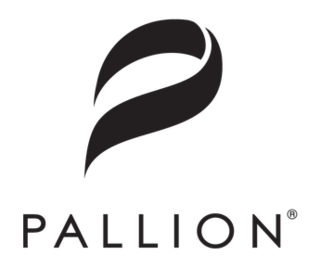
Pallion designs, manufactures, and distributes precious metal products and related services. It is the largest precious metal services group in Australasia. Pallion is the result of the merger of the ABC Bullion and Palloys Group of companies founded in 1972 and 1951 respectively. The group maintains its headquarters in Sydney NSW Australia and is a wholly privately owned group of companies with manufacturing facilities and offices in Sydney, Melbourne, Brisbane and Perth in Australia, Hong Kong (SAR) and mainland China.













